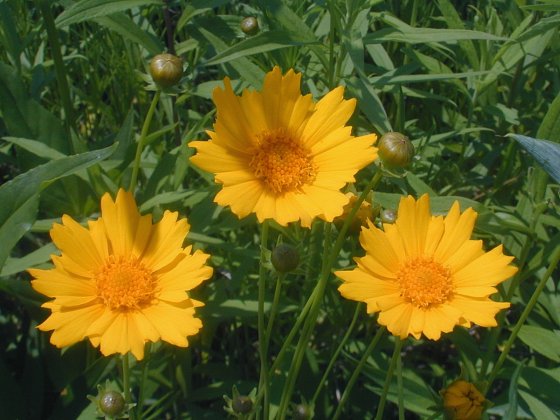Description: This perennial plant is about 2' tall, unbranched, and hairless. The leaves are arranged oppositely or alternately at intervals along the stem (usually the former). They are pinnatifid and deeply lobed. The leaf segments are linear and rather irregular; the terminal segment is usually the largest. A few leaves at the bottom or the top may be linear and lack lobes. These leaves are up to 3" long and 2" across, although the linear leaf segment are less than ¼" across. At the apex of the plant, is a rather long and naked flowering stem with a single composite flower about 2½" across. It consists of 6-12 yellow ray florets that surround numerous golden yellow disk florets. Each ray floret has 4-5 notches along the outer edge. This provides the composite flower with an attractive, somewhat ragged, appearance. The blooming period occurs during early to mid-summer and lasts about a month. This is little or no floral scent. The flowerbuds have a smooth, spherical appearance, and are olive green. The achenes are flat and rather oblong, with two have small scales at the apex. They are distributed to a limited extent by the wind. The root system has rhizomes, causing colonies to be formed.

Cultivation:
The
preference is full sun and dry conditions. This plant is typically
found in a rather heavy soil containing clay or gravel. At a
well-drained site, it is an easy plant to grow, and has few problems
with foliar disease.
Range & Habitat:
The non-native Large-Flowered Coreopsis occurs primarily in western
Illinois and the
Chicago area (see Distribution
Map). This plant is originally from areas that lie west and
southwest of Illinois, but it has since spread as an occasional escape
from cultivation and other disturbances of modern development. In
Illinois, it is a rather uncommon plant, but probably occurs in more
areas than official records indicate. Habitats include upland areas of
prairie (including prairie restorations), openings in rocky upland
forests, thickets, glades, roadsides, and miscellaneous waste areas.
Faunal Associations:
Like other coreopsis species, a wide range of insects are probably
attracted to the flowers, including long-tongued bees, short-tongued
bees, butterflies, and skippers. These insects usually seek nectar,
although bees sometimes collect pollen. An oligolege of Coreopsis
spp. is Melissodes coreopsis (Coreopsis
Miner Bee). The larvae of the moths Tornos scolopacinarius
(Dimorphic Gray) and Enychlora acida (Wavy-Lined
Emerald) feed on the foliage or flowerheads. Such mammalian herbivores
as rabbits, groundhogs, livestock, and probably deer occasionally
consume the foliage as well.

Photographic
Location:
The photographs were taken at Meadowbrook Park in Urbana, Illinois.
Comments:
Large-Flowered Coreopsis has showy flowers and attractive foliage. For
these reasons, it is often available through the nursery trade and
cultivated in gardens. This species can be distinguished from other Coreopsis
spp. by the ragged appearance of the flower petals, and the
linear pinnate leaves that occur along the stems, usually in opposite
pairs. The species Coreopsis lanceolata (Sand
Coreopsis) has ragged-looking petals, but its leaves are primarily
lanceolate or oblanceolate in shape and confined near the base of the
central stem. An eastern species that hasn't been observed in Illinois
in natural areas, Coreopsis verticillata (Whorled
Coreopsis), has leaves with a similar appearance, but they occur in
whorls of three along the central stem. Also, the flowers of Whorled
Coreopsis don't have a ragged appearance because their petals lack
conspicuous outer notches. The narrowness of the leaves of
Large-Flowered Coreopsis is somewhat variable, depending on the variety.